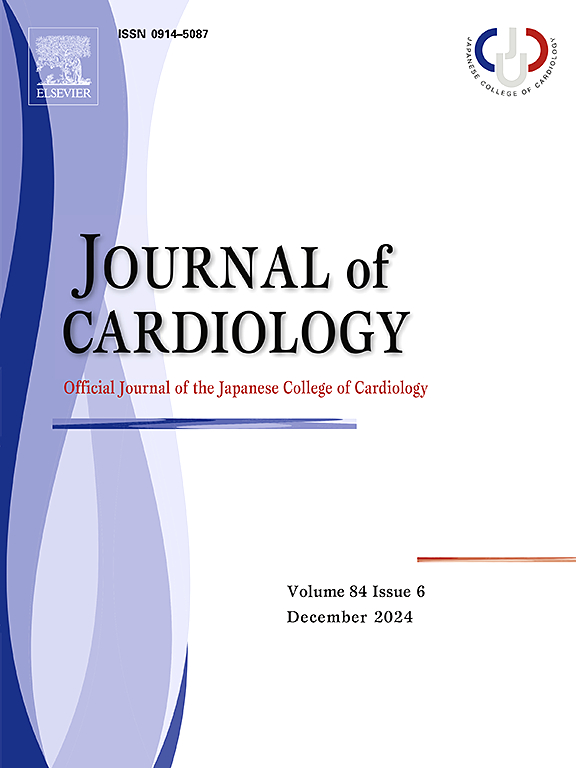接受沙库比妥/缬沙坦或依那普利治疗的日本心力衰竭患者发生低血压相关不良事件的几率和风险因素:PARALLEL-HF 研究结果。
IF 2.5
3区 医学
Q2 CARDIAC & CARDIOVASCULAR SYSTEMS
引用次数: 0
摘要
研究背景PARALLEL-HF 试验显示,在日本心力衰竭(HF)和射血分数降低的患者中,与依那普利相比,使用沙库比妥/缬沙坦治疗会导致更多症状性低血压,这与 PARADIGM-HF 类似。在这些患者中使用沙库比普利/缬沙坦可能会受到低血压问题的限制:这项事后分析利用 PARALLEL-HF 的数据分析了与低血压相关的不良事件(AEs)及其对疗效的影响,在 PARALLEL-HF 中,患者接受了每日两次、每次 200 毫克的沙库比特利/缬沙坦或每日两次、每次 10 毫克的依那普利治疗:在 223 名患者中,28.2% 的患者出现了低血压相关的 AEs,而使用沙库比妥/缬沙坦的发生率高于依那普利(危险比为 2.2;95 % CI 为 1.3-3.8;p = 0.0027)。然而,从基线到研究结束,平均收缩压的降低幅度并无显著差异(沙库比特利/缬沙坦:-2.2 mmHg vs 依那普利:-1.3 mmHg;p = 0.6895)。出现低血压相关不良反应的患者平均体重指数较低,随机化时 N 末端脑钠肽中位数较高,中风病史较多。导致中断治疗的低血压相关不良反应在沙库比特利/缬沙坦与依那普利之间没有显著差异(3.4% vs 6.9%,p = 0.5957)。在出现或未出现低血压相关AEs的患者中,使用沙库比妥/缬沙坦与依那普利相比,降低心血管死亡或高血压住院风险的效果相似:结论:低血压相关不良反应的发生率在沙库比特利/缬沙坦组高于依那普利组,但并不影响心血管死亡或心房颤动住院的风险,治疗组之间的风险相似。本文章由计算机程序翻译,如有差异,请以英文原文为准。

Incidence and risk factors of hypotension-related adverse events among Japanese patients with heart failure receiving sacubitril/valsartan or enalapril: Results from the PARALLEL-HF study
Background
The PARALLEL-HF trial showed that treatment with sacubitril/valsartan resulted in more symptomatic hypotension versus enalapril in Japanese patients with heart failure (HF) and reduced ejection fraction, similar to PARADIGM-HF. Use of sacubitril/valsartan in these patients may be limited by concerns regarding hypotension.
Methods
This post-hoc analysis characterized hypotension-related adverse events (AEs) and their effects on efficacy using data from PARALLEL-HF, in which patients received sacubitril/valsartan 200 mg twice daily or enalapril 10 mg twice daily.
Results
Of 223 patients, 28.2 % experienced hypotension-related AEs and incidence was higher with sacubitril/valsartan versus enalapril (hazard ratio, 2.2; 95 % CI, 1.3–3.8; p = 0.0027). However, reduction in mean systolic blood pressure from baseline to study end did not significantly differ (sacubitril/valsartan: −2.2 mmHg vs enalapril: −1.3 mmHg; p = 0.6895). Patients who experienced hypotension-related AEs had lower mean body mass index, higher median N-terminal pro-brain natriuretic peptide at randomization, and more frequent history of stroke. Hypotension-related AEs leading to treatment discontinuation were not significantly different for sacubitril/valsartan versus enalapril (3.4 % vs 6.9 %, p = 0.5957). Reduction in risk of cardiovascular death or HF hospitalization was similar with sacubitril/valsartan versus enalapril in patients with or without hypotension-related AEs.
Conclusions
Incidence of hypotension-related AEs was higher in the sacubitril/valsartan versus enalapril group but did not affect risk of cardiovascular death or HF hospitalization, which was similar between treatment groups.
求助全文
通过发布文献求助,成功后即可免费获取论文全文。
去求助
来源期刊

Journal of cardiology
CARDIAC & CARDIOVASCULAR SYSTEMS-
CiteScore
4.90
自引率
8.00%
发文量
202
审稿时长
29 days
期刊介绍:
The official journal of the Japanese College of Cardiology is an international, English language, peer-reviewed journal publishing the latest findings in cardiovascular medicine. Journal of Cardiology (JC) aims to publish the highest-quality material covering original basic and clinical research on all aspects of cardiovascular disease. Topics covered include ischemic heart disease, cardiomyopathy, valvular heart disease, vascular disease, hypertension, arrhythmia, congenital heart disease, pharmacological and non-pharmacological treatment, new diagnostic techniques, and cardiovascular imaging. JC also publishes a selection of review articles, clinical trials, short communications, and important messages and letters to the editor.
 求助内容:
求助内容: 应助结果提醒方式:
应助结果提醒方式:


